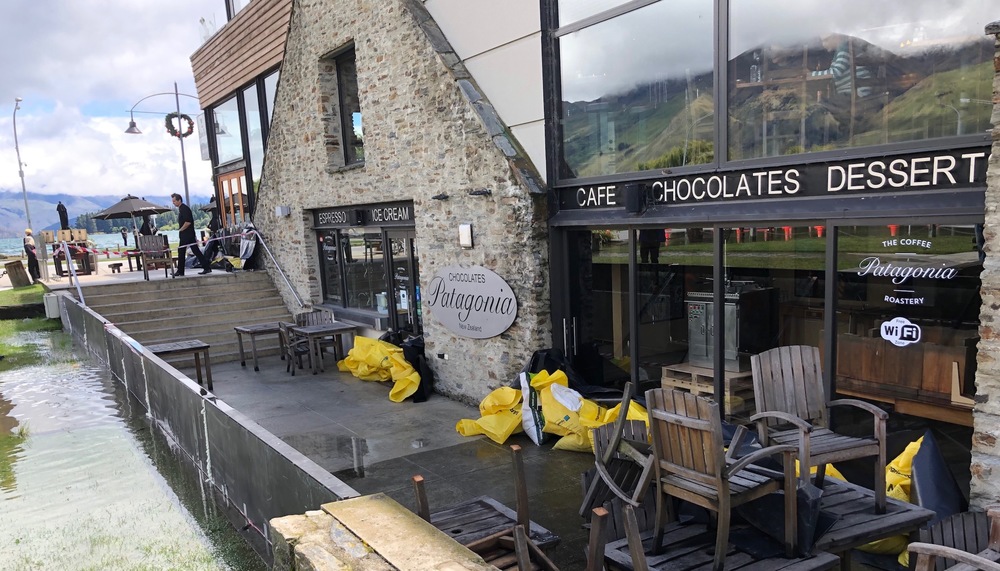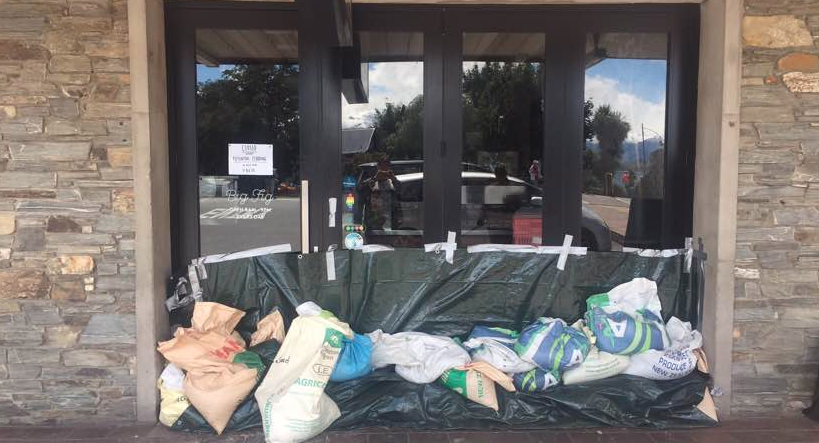Better late than never: floodwater management discussed
Diana Cocks
26 December 2020, 8:54 PM
 The floodwater markers outside Kai Whakapai keep track of major floods affecting Wanaka.
The floodwater markers outside Kai Whakapai keep track of major floods affecting Wanaka.A 2019 marker has joined the five other stainless steel markers outside Kai Whakapai recording the dates of the six most notable floods of central Wanaka.
Eleven months after the December 2019 flood of Wanaka’s central business district, which closed roads and forced many businesses to shut, a meeting of local business operators, elected members, contractors and staff of the Queenstown Lakes District Council (QLDC) and Otago Civil Defence Emergency Management was held in Wanaka (November 2).
Wanaka CBD property owners’ group representative Roger Gardiner, who had been critical of the QLDC’s slow response to discuss how to better manage future floods, said the meeting was productive.
He said while no-one expects to hold the flood waters back during a big flood they all agreed with better planning “we can be smarter on how we manage [the floodwaters] and we should be able to keep the town operating”.
“It comes at a cost to everyone when streets are closed for four or five days,” Roger said.

The metal barrier was deployed to keep water out of Patagonia Chocolates on December 5.
Consideration was given to creating a bund (raised ground) along the CBD foreshore to reduce the impact of water entering the CBD, with work expected to start early next year, he said.
Options to use a boom or sandbag the low lying area on the lakeside of Ardmore Street were also discussed, as was the option of having on standby two appropriately sized pumps, specifically designed to mitigate the impact of floodwaters, which could be deployed at short notice.
Some businesses were forced to close last December, even though they were unaffected by floodwaters, because the council shut down the sewerage infrastructure amid fears of contamination. As a result, council engineering staff will investigate what options are viable to allow stormwater and sewerage infrastructure to remain operational during a similar flood event, Roger said.

Big Fig was closed by rising floodwaters.
Further clarification regarding local authority announcements which enabled tenants’ insurance cover to be triggered was also sought, he said.
Meeting participants also agreed it was desirable to have a QLDC representative with delegated authority in Wanaka to improve response times and the coordination of resources.
QLDC media spokesperson Jack Barlow said in future flooding events, a QLDC emergency management officer will be “a visible presence in Wanaka...working alongside the community, contractors and other stakeholders”.
He added that Wanaka’s Lakefront Development Plan (stage four: the CBD foreshore area) will consider flood mitigation measures for more frequent events.
Roger said evidence of the impact of climate change made it all the more compelling for council to revise its existing Flood Risk Management Strategy for the communities of Lakes Wakatipu and Wanaka - which was published 14 years ago.
“Flood guidelines for lakefront businesses to provide information on how to prepare for floods (including emergency plans and business continuity plans), and what to do and where to go when flooding occurs, are currently being updated,” Jack said.
Roger said while the meeting was constructive he is disappointed there has been no effort from the QLDC and its contractors to document proposed actions and keep key stakeholders informed.
“Council staff and contractors [are] to come up with a simple new plan [but] there is no agreed time frame or allocation of responsibility to convene a future meeting with stakeholders. We find this very frustrating,” Roger said.
PHOTOS: Wanaka App

